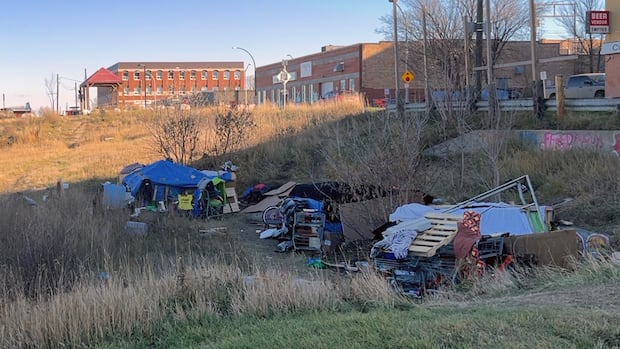ManitobaWhile the province launched its plan to end chronic homelessness almost a year ago, it hasn’t been implemented in Brandon yet. The provincial minister for homelessness says the province is working to expand housing, but there’s no timeline on when the plan will arrive in Manitoba’s second-biggest city. Manitoba government’s plan to end chronic homelessness hasn’t expanded beyond Winnipeg yetChelsea Kemp · CBC News · Posted: Nov 07, 2025 6:00 AM EST | Last Updated: 2 hours agoListen to this articleEstimated 5 minutesThe audio version of this article is generated by text-to-speech, a technology based on artificial intelligence.The estimated number of reported encampments in Brandon has doubled compared to last year, according to the city’s community housing and wellness co-ordinator. (Chelsea Kemp/CBC)As freezing temperatures return, Brandon has reopened a temporary overnight drop-in to help people escape the cold — but those who work with homeless people in Manitoba’s second-biggest city say short-term fixes aren’t enough, and more permanent supportive housing is needed.The non-profit social services agency Life’s Journey will operate the drop-in warming shelter for the first time this year. It was initially created in 2022 to ease pressures on the city’s only overnight shelter, which had reached capacity.This year’s opening comes as homelessness rises and the estimated number of reported encampments has doubled compared to last year in the city, according to Shannon Saltarelli, the City of Brandon’s community housing and wellness co-ordinator. She and other advocates say long-term housing and sustainable provincial investment are urgently needed.”We’ve seen a lot of people enter back into homelessness who were previously housed, which is very concerning,” Saltarelli said. Shannon Saltarelli, Brandon’s community housing and wellness co-ordinator, says the city needs more supportive, transitional and affordable housing. (Chelsea Kemp/CBC)Providing shelter space to keep people safe is important, “but that’s not the solution to homelessness,” she said.”Most importantly, we need to … get them into safe and appropriate housing.”In January, the province launched its “Your Way Home” plan to end chronic homelessness, which focuses on moving people from encampments into permanent housing. However, that plan hasn’t yet been implemented in Brandon.Mayor Jeff Fawcett said the city is collaborating with community groups and other levels of government to address housing concerns.”The province does want housing of some kind. They’re less inclined to just add more overnight beds,” Fawcett said.While housing isn’t a municipal responsibility, the city is working to find solutions, he said.”A lot of things have to fall into place. But we’re at the table with [the province],” he said.Housing, Addictions and Homelessness Minister Bernadette Smith told CBC the province is working to expand housing, but her office confirmed the NDP government’s homelessness strategy has not expanded outside Winnipeg, and there’s no timeline for it to come to Brandon.According to the province, as of last month, the Your Way Home strategy had been able to provide housing to 100 people from encampments in Winnipeg.City needs emergency plan: Samaritan HouseThe NDP government has faced criticism over its progress on reducing homelessness in Manitoba. A recent report from End Homelessness Winnipeg, a non-profit housing advocacy group, said it counted a record 2,469 people experiencing homelessness in its street census last November. That data is gathered through a point-in-time count, meant to provide a snapshot of homelessness over a short period of time.A point-in-time homelessness count in Brandon, which took place over 24 hours last October, identified 229 people without homes — up by 100 people compared to 2021.So far this year, about 766 individuals in Brandon have experienced homelessness at some point, says Rebecca Anhalt, a senior data analyst with Brandon’s Homeless Individuals and Families Information System — an ongoing database that tracks homelessness in the city.Rebecca Anhalt is Brandon’s Homeless Individuals and Families Information System senior data analyst. (Chelsea Kemp/CBC)The number of people considered chronically homeless has climbed from 126 in 2023 to 216 this year, she said, but she cautions data is less reliable this year, because “we actually have fewer resources for individuals to access.”That means some people experiencing homelessness may not have been counted, said Anhalt.Since spring, Brandon has had no dedicated daytime drop-in spaces, limiting data collection and leaving unhoused people with nowhere to go during the day.”We’re seeing a lot of returns to homelessness,” Anhalt said. “That’s telling me that there’s gaps in supports and resources.”Heather Symbalisty, executive director of Samaritan House Ministries, says the city needs an emergency plan for when the shelter reaches capacity. (Chelsea Kemp/CBC)The overnight drop-in helps ease pressure on Brandon’s Safe and Warm shelter, says Heather Symbalisty, the executive director of Samaritan House Ministries, which runs the shelter.It had to turn more than 30 people away last January, when the shelter reached its 41-person capacity. She expects to see similar numbers again this winter. “We as a community don’t have an emergency plan for when we hit capacity,” she said. “We can send individuals to the drop-in centre, but that isn’t a place where they can actually sleep.”The Life’s Journey overnight drop-in, which is open daily from 7:45 p.m. to 7:30 a.m., has room for up to 25 people. It’s staffed by two workers and a security guard. Lorraine Ratcliffe, the Westman and Central Manitoba director for Life’s Journey, said the drop-in aims to provide a welcoming space while connecting visitors with other supports in the city.Life’s Journey Westman and Central Manitoba director Lorraine Ratcliffe says the drop-in warming space has already seen high use in its first week this year. (Chelsea Kemp/CBC)The drop-in, which opened Oct. 29, saw high demand in its first week, with 39 people using the space on opening day and more than 60 over the weekend, Ratcliffe said. The hope is to keep the drop-in open until April, using $350,000 in provincial funding.Homeless people in the city “need a place that they can go … [and] feel connected to,” she said.”And we can hopefully … connect them to resources outside of Life’s Journey.”ABOUT THE AUTHORChelsea Kemp is a multimedia journalist with CBC Manitoba. She is based in CBC’s bureau in Brandon, covering stories focused on rural Manitoba. Share your story ideas, tips and feedback with chelsea.kemp@cbc.ca.
Monday, 22 Dec 2025
Canada – The Illusion
Search
Have an existing account?
Sign In
© 2022 Foxiz News Network. Ruby Design Company. All Rights Reserved.
You May also Like
- More News:
- history
- Standing Bear Network
- John Gonzalez
- ᐊᔭᐦᑊ ayahp — It happened
- Creation
- Beneath the Water
- Olympic gold medal
- Jim Thorpe
- type O blood
- the bringer of life
- Raven
- Wás’agi
- NoiseCat
- 'Sugarcane'
- The rivers still sing
- ᑲᓂᐸᐏᐟ ᒪᐢᑿ
- ᐅᑳᐤ okâw — We remember
- ᐊᓂᓈᐯᐃᐧᐣ aninâpêwin — Truth
- This is what it means to be human.
- Nokoma











